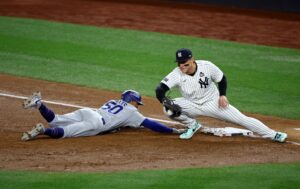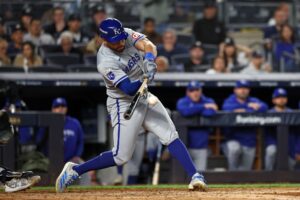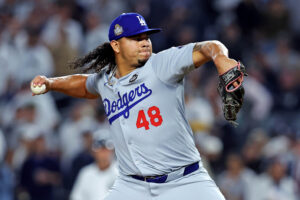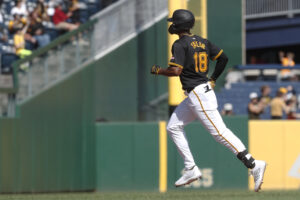Motor On Revs into High Gear in 1984
In the third installment of our “Reliving History” series, the focus turns to the 1984 Detroit Tigers. The Tigers were a dominant force in baseball during the 1984 season. In many ways, the Tigers had the formidable characteristics of a true contending team that year with pitching, defense, and a potent offense.
Under the guidance of Sparky Anderson, also known as Captain Hook, the Tigers finished the year in first place in the American League East. Detroit went on to post a 104-58 record during the regular season. Furthermore, the Tigers advanced to the postseason and go on to win a World Series Championship.
While the 1984 Detroit Tigers came away from the year with a ring on their finger, what made them so great? Besides pitching, defense, and a potent offense, there were some special players on the Tigers roster that year. Below we will look at each of those players in further depth.
Lance Parrish and Kirk Gibson Led Offense
During the 1984 season, the two main pillars of the Detroit Tigers offense were catcher/designated hitter Lance Parrish and right fielder Kirk Gibson. Both Parrish and Gibson had phenomenal seasons in 1984. They both contributed so much to the Tigers at the plate that Detroit led the American League in scoring.
At 28 years old, Parrish slugged .237/.287/.443 with 33 home runs and 98 RBI over 629 plate appearances. Parrish was a key contributor during the 1984 season, and it resulted in several accolades. He was named an All-Star for a third consecutive season, won his second Gold Glove, and fourth Silver Slugger Award.
Besides Parrish providing a spark at the plate, he was brilliant behind the dish. He recorded a Caught Stealing Percentage (CS%) of 46%, which was well above the league average of 36%. As a result, Parrish won a Gold Glove that season.
In addition, right fielder Kirk Gibson was a force at the plate. Gibson concluded the season with a .282/.363/.516 slash line over 611 plate appearances. In that span, Gibson recorded 23 doubles, 10 triples, 27 home runs, and 91 RBI. It wasn’t just at the plate that Gibson shined either. He was also aggressive on the base paths for the Tigers.
During the 1984 regular season, Gibson recorded 29 stolen bases. That was the third-most stolen bases that he recorded during a regular season with the Tigers. When you combine all of Gibson’s contributions, it resulted in the outfielder finishing sixth in American League Most Valuable Player Award voting.
Middle Infield Combo for the Ages
One of the things that stands out the most about the Tigers teams of the 1970s and 1980s is the middle infield duo of second baseman Lou Whitaker and shortstop Alan Trammell. Both Whitaker and Trammell were beloved by the entire Tigers fanbase. In many ways, the city found both players easy to root for, and both Whitaker and Trammell established a brand for Tigers baseball.
During the 1984 season, Whitaker earned an All-Star nod and won a Gold Glove and Silver Slugger Award. Whitaker always seemed to find a way to get on-base, as illustrated by his on-base percentage of .357. Stellar defense was also another selling point for Whitaker.
The then 26-year-old Trammell was just entering his peak during the 1984 season. As was the case with Whitaker, Trammell knew how to get on base when it mattered most. Additionally, defense was a shining point for Trammell. During the 1984 season, he finished the season with a cumulative fielding percentage of .980.
Combined, both Whitaker and Trammell posted a Wins Above Replacement (WAR) value of 11.1. When you take that into consideration, it’s not only impressive but demonstrates how talented both players truly were.
Outside of the 1984 regular season, both Whitaker and Trammell were staples in the Tigers organization. As a duo, they played together in 1,918 games, which is the most of any double play combination in MLB history.
Morrisfied: Jack Morris Leads the Starting Rotation
The biggest feature of the Tigers starting rotation was right-hander Jack Morris. The Hall of Fame starting pitcher was right in the middle of his peak during the 1984 season at 29 years old. As a result, Morris went on to make 35 starts.
Over those 35 starts, Morris posted a 3.60 ERA with a 3.73 Fielding Independent Percentage (FIP) and a 5.5 K/9 rate. When the 1984 regular season started, the Tigers won their first nine games and 16 of their first 17 matchups. In that span, Morris recorded four wins alone, which speaks to the type of pitcher that he was.
In fact, Morris got the nod to be the Tigers Opening Day starter that season. The game was played against the Minnesota Twins at the Hubert H. Humphrey Metrodome. Morris shined by throwing seven innings and helped lead Detroit to an 8-1 victory. Throughout his big league career, Morris never lost a game in Minnesota.
During the 1984 regular season, Morris was yet another All-Star for the Tigers. Additionally, the right-hander finished seventh in American League Cy Young Award voting.
Dan Petry’s Contributions
The 25-year-old Dan Petry enjoyed the best season of his big league career in 1984. While it might not have been as impressive or recognizable as that of the aforementioned Jack Morris, Petry still provided an impactful workload for the Tigers.
Across 35 starts, Petry recorded a 3.24 ERA over 233.1 innings of work. In that stretch, Petry faced a total of 968 batters, posted a 3.59 FIP, and struck out 144 batters. Furthermore, he ended the regular season with an ERA+ of 121 and a 1.27 WHIP.
When the postseason rolled around, Petry was given the starting nod twice. The first appearance came against the Kansas City Royals during the American League Championship Series. During that outing, Petry recorded a 2.57 ERA over seven innings of work, while surrendering four hits and two earned runs and striking out four batters.
The second appearance in the postseason came during the World Series. Petry wasn’t nearly as brilliant — surrendering fourteen hits and five walks while conceding eight earned runs. While the surface-level stats weren’t nice for Petry during that outing, he did go the distance, completing eight innings.
Willie Hernandez Shuts the Door
Any championship-caliber baseball team, let alone one that goes on to win a World Series Championship, needs a lock-down reliever to shut the door at the end of a game. That’s exactly what left-hander Guillermo “Willie” Hernandez did for the Tigers, especially during the 1984 season.
During the 1984 regular season, Hernandez pitched in a career-high 80 games. Of those 80 games, Hernandez finished 68 of them, posting a 1.92 ERA. In that span, Hernandez recorded 112 strikeouts and an ERA+ of 204. Hernandez’s impact was so significant that season that he won both the American League Cy Young and Most Valuable Player Award! Talk about a rarity for a pitcher to win both awards. Let alone a reliever!
Hernandez was impactful at Tiger Stadium but was even more effective for Detroit on the road. Hernandez held opponents to a .215/.274/.269 slash line at home, but on the road, opponents were held to a .173/.232/.240 line. That translated into a road ERA of 1.69 over 74.2 innings of work.
Motor On Shines Bright in 1984
Altogether, the 1984 Detroit Tigers were a very special team. The team got off to a hot start over their first 40 games, posting a 35-5 record, and tied the 1916 New York Giants for the most consecutive road wins at 17. Additionally, they were led by a highly skilled manager in Sparky Anderson, who became the first manager to win over 100 games in both leagues.
When you combine the team’s chemistry, potent offense, and defense, it resulted in what took place during the 1984 season. For the Tigers, that year would mark the last season that resulted in a World Series Championship. Detroit would go onto play in both the 2006 and 2012 World Series but would lose out on both.
Main Photo:
Embed from Getty Images






